Plantation Technology
in the West Indies
Port St. George Project
Investigates Eighteenth Century Sugar Plantation on Nevis.
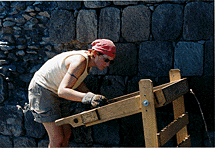 In July and August of 1997, students from
the Industrial Archaeology program at Michigan Tech conducted
the first systematic survey and excavations of sugar plantation
and harbor complex on the island of Nevis, in the West Indies.
Colonial artifacts found during the excavation helped date the
active period of the site from the late seventeenth through the
early nineteenth centuries. Recovered material included slave
made colonoware, gunspalls, typical European colonial wares, and
trade porcelain. Industrial artifacts found include an iron windmill
mainshaft, parts of a vertical three-roller cane mill, and iron
cauldrons.
In July and August of 1997, students from
the Industrial Archaeology program at Michigan Tech conducted
the first systematic survey and excavations of sugar plantation
and harbor complex on the island of Nevis, in the West Indies.
Colonial artifacts found during the excavation helped date the
active period of the site from the late seventeenth through the
early nineteenth centuries. Recovered material included slave
made colonoware, gunspalls, typical European colonial wares, and
trade porcelain. Industrial artifacts found include an iron windmill
mainshaft, parts of a vertical three-roller cane mill, and iron
cauldrons.
Photo: Michigan Tech graduate student Amanda Gronhovd screens
material from excavation Behind her is the wall of the two story
complex
Photo below: The island of Nevis from the northwest.
Nevis Peak shrouded in clouds.
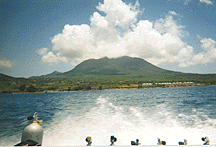 Although Columbus sighted the island in 1493,
the island remained unmolested by Europeans until English colonists
arrived from the neighboring island, St. Kitts, in 1627, establishing
tobacco, indigo, and ginger plantations. By 1650, however, sugar
production came to dominate the colony's economy. Sugar production,
and the trade in slaves which sustained the industry, drove Nevis
to the forefront of the emerging global economy of the eighteenth
century. Located at the northern end of the Leeward islands just
west of Antigua, Nevis was well situated for colonial enterprise.
Once so prosperous from the sugar and slave trade that it was
called the "Queen of the Caribbees," today only stone
ruins remain as silent testimony to the industrial past. Nevis
is better known as the birthplace of Alexander Hamilton, and where
a young Captain Horatio Nelson met, and married, Frances Nesbit,
in 1787. Nelson was in command of a squadron of ships sent by
England to prevent trade between Nevis and the new nation of the
United States, in violation of the Molasses Act. The island's
dominance of the sugar trade was eventually eclipsed during the
era of steam powered mills, nevertheless, Nevis continued to play
an important role in the industry until the mid nineteenth century.
Although Columbus sighted the island in 1493,
the island remained unmolested by Europeans until English colonists
arrived from the neighboring island, St. Kitts, in 1627, establishing
tobacco, indigo, and ginger plantations. By 1650, however, sugar
production came to dominate the colony's economy. Sugar production,
and the trade in slaves which sustained the industry, drove Nevis
to the forefront of the emerging global economy of the eighteenth
century. Located at the northern end of the Leeward islands just
west of Antigua, Nevis was well situated for colonial enterprise.
Once so prosperous from the sugar and slave trade that it was
called the "Queen of the Caribbees," today only stone
ruins remain as silent testimony to the industrial past. Nevis
is better known as the birthplace of Alexander Hamilton, and where
a young Captain Horatio Nelson met, and married, Frances Nesbit,
in 1787. Nelson was in command of a squadron of ships sent by
England to prevent trade between Nevis and the new nation of the
United States, in violation of the Molasses Act. The island's
dominance of the sugar trade was eventually eclipsed during the
era of steam powered mills, nevertheless, Nevis continued to play
an important role in the industry until the mid nineteenth century.
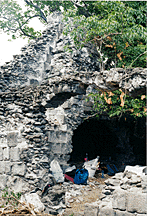 Abandonment by planters, and the lack of extensive
development has allowed several archaeological sites to escape
disturbance. Remains of plantations, stone windmill towers, boiling
houses, and other elements of the sugar industry decorate the
landscape. In a few locations, late nineteenth century steam engines
can still be found on their original mountings. However, many
of the island's historic structures remain undocumented, and adaptive
reuse of building materials by Nevisans is beginning to take a
toll on the historic industrial landscape.
Abandonment by planters, and the lack of extensive
development has allowed several archaeological sites to escape
disturbance. Remains of plantations, stone windmill towers, boiling
houses, and other elements of the sugar industry decorate the
landscape. In a few locations, late nineteenth century steam engines
can still be found on their original mountings. However, many
of the island's historic structures remain undocumented, and adaptive
reuse of building materials by Nevisans is beginning to take a
toll on the historic industrial landscape.
Unique among these vestiges of industry is the site located
on the dry, windswept, southern side of the island, at Indian
Castle Bay. In 1704, the Nevis Council declared the harbor located
at the bay a "shipping place" in order to facilitate
and encourage sugar production and settlement along the island's
south coast. Historic documents refer to the site as the "shipping
place of St. George Parish." Remains of the Indian Castle
Estate stand on the cliffs overlooking the harbor.
Photo: Example of stone architecture found at the site complex.
The view looks through a doorway arch into a room with a 2 meter
wide fireplace. The room served as a field office for the project
crew.
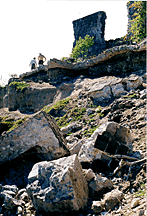 At the invitation
of the Nevis Historical Conservation Society an expedition from
Michigan Tech, led by Master degree candidate Marco Meniketti,
and Professor David Landon, traveled to Nevis to investigate the
ruins. Several structures are imperiled with destruction from
erosion and collapse, and the NHCS has been concentrating its
efforts on documenting the buildings. Because the location also
served as a port, the NHCS was also interested in identifying
structures associated with shipping.
At the invitation
of the Nevis Historical Conservation Society an expedition from
Michigan Tech, led by Master degree candidate Marco Meniketti,
and Professor David Landon, traveled to Nevis to investigate the
ruins. Several structures are imperiled with destruction from
erosion and collapse, and the NHCS has been concentrating its
efforts on documenting the buildings. Because the location also
served as a port, the NHCS was also interested in identifying
structures associated with shipping.
The crew from Michigan Tech surveyed the site and documented
several structures associated with sugar production, including
a stone windmill, sugar works, and a two-story complex which may
have served as a harbor warehouse. Drawings produced the year
before by Caribbean Volunteer Expeditions, from New York, were
a significant aid to field work and provided a benchmark for determining
the rate of deterioration of site structures. In a span of less
than one year one wall of the two-story complex, which stands
on a cliff overlooking the harbor, were found to have collapsed
into the sea.
The cliff side complex, measuring more than 50 meters by 70
meters had within its walls a stone cistern, a vaulted chamber
supporting a staircase, a "kitchen," and two long "galleries."
Photo:The cliff side complex. The outer wall of the complex
has collapsed to the beach. The 40 cm thick undulating mortar
floor of the structure is visible along upper portion of photo.
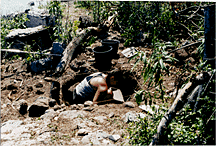 Excavations revealed
iron cauldrons, probably used for molasses collection, set into
an undulating mortar and cobble floor. The undulations created
drainage channels which fed directly to the cauldrons. While iron
cauldrons of various types can literally be found everywhere on
the landscape in Nevis, these were the first ever found in situ
from the eighteenth century.
Excavations revealed
iron cauldrons, probably used for molasses collection, set into
an undulating mortar and cobble floor. The undulations created
drainage channels which fed directly to the cauldrons. While iron
cauldrons of various types can literally be found everywhere on
the landscape in Nevis, these were the first ever found in situ
from the eighteenth century.
Photo:Michigan Tech student Tanya Elliott records an iron
cauldron exposed in an excavation unit.
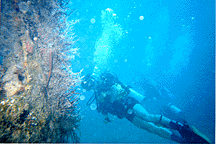 Diving teams under
the direction of Marco Meniketti also conducted a preliminary
underwater survey of the harbor area, finding numerous iron concretions,
architectural artifacts, and two cannon. The ordnance is indicative
of either shipping or coastal defenses of the late seventeenth
and early eighteenth centuries when the island was under constant
threat of invasion by French forces. A detailed account of the
submerged cultural resources can be found in the soon to be published
1998 edition of Underwater Archaeology by the Society for Historical
Archaeology.
Diving teams under
the direction of Marco Meniketti also conducted a preliminary
underwater survey of the harbor area, finding numerous iron concretions,
architectural artifacts, and two cannon. The ordnance is indicative
of either shipping or coastal defenses of the late seventeenth
and early eighteenth centuries when the island was under constant
threat of invasion by French forces. A detailed account of the
submerged cultural resources can be found in the soon to be published
1998 edition of Underwater Archaeology by the Society for Historical
Archaeology.
Photo:Expedition diver Lisa Meniketti examines a stone block
covered in thick marine growth.
The project team completed a map of the plantation site and
produced detailed drawings of several structures. Iron artifacts
of presteam era milling and sugar manufacturing were also recorded
in detail. Future projects at the site are under consideration.
For more information contact: Marco Meniketti,
2635 Hopkins Ave., Lansing, MI 48912
email: meniketti.marco-lisa@att.net
Start | Program | Application
Information | SIA
Projects | Field
School | Social Science Department
 In July and August of 1997, students from
the Industrial Archaeology program at Michigan Tech conducted
the first systematic survey and excavations of sugar plantation
and harbor complex on the island of Nevis, in the West Indies.
Colonial artifacts found during the excavation helped date the
active period of the site from the late seventeenth through the
early nineteenth centuries. Recovered material included slave
made colonoware, gunspalls, typical European colonial wares, and
trade porcelain. Industrial artifacts found include an iron windmill
mainshaft, parts of a vertical three-roller cane mill, and iron
cauldrons.
In July and August of 1997, students from
the Industrial Archaeology program at Michigan Tech conducted
the first systematic survey and excavations of sugar plantation
and harbor complex on the island of Nevis, in the West Indies.
Colonial artifacts found during the excavation helped date the
active period of the site from the late seventeenth through the
early nineteenth centuries. Recovered material included slave
made colonoware, gunspalls, typical European colonial wares, and
trade porcelain. Industrial artifacts found include an iron windmill
mainshaft, parts of a vertical three-roller cane mill, and iron
cauldrons. Although Columbus sighted the island in 1493,
the island remained unmolested by Europeans until English colonists
arrived from the neighboring island, St. Kitts, in 1627, establishing
tobacco, indigo, and ginger plantations. By 1650, however, sugar
production came to dominate the colony's economy. Sugar production,
and the trade in slaves which sustained the industry, drove Nevis
to the forefront of the emerging global economy of the eighteenth
century. Located at the northern end of the Leeward islands just
west of Antigua, Nevis was well situated for colonial enterprise.
Once so prosperous from the sugar and slave trade that it was
called the "Queen of the Caribbees," today only stone
ruins remain as silent testimony to the industrial past. Nevis
is better known as the birthplace of Alexander Hamilton, and where
a young Captain Horatio Nelson met, and married, Frances Nesbit,
in 1787. Nelson was in command of a squadron of ships sent by
England to prevent trade between Nevis and the new nation of the
United States, in violation of the Molasses Act. The island's
dominance of the sugar trade was eventually eclipsed during the
era of steam powered mills, nevertheless, Nevis continued to play
an important role in the industry until the mid nineteenth century.
Although Columbus sighted the island in 1493,
the island remained unmolested by Europeans until English colonists
arrived from the neighboring island, St. Kitts, in 1627, establishing
tobacco, indigo, and ginger plantations. By 1650, however, sugar
production came to dominate the colony's economy. Sugar production,
and the trade in slaves which sustained the industry, drove Nevis
to the forefront of the emerging global economy of the eighteenth
century. Located at the northern end of the Leeward islands just
west of Antigua, Nevis was well situated for colonial enterprise.
Once so prosperous from the sugar and slave trade that it was
called the "Queen of the Caribbees," today only stone
ruins remain as silent testimony to the industrial past. Nevis
is better known as the birthplace of Alexander Hamilton, and where
a young Captain Horatio Nelson met, and married, Frances Nesbit,
in 1787. Nelson was in command of a squadron of ships sent by
England to prevent trade between Nevis and the new nation of the
United States, in violation of the Molasses Act. The island's
dominance of the sugar trade was eventually eclipsed during the
era of steam powered mills, nevertheless, Nevis continued to play
an important role in the industry until the mid nineteenth century. Abandonment by planters, and the lack of extensive
development has allowed several archaeological sites to escape
disturbance. Remains of plantations, stone windmill towers, boiling
houses, and other elements of the sugar industry decorate the
landscape. In a few locations, late nineteenth century steam engines
can still be found on their original mountings. However, many
of the island's historic structures remain undocumented, and adaptive
reuse of building materials by Nevisans is beginning to take a
toll on the historic industrial landscape.
Abandonment by planters, and the lack of extensive
development has allowed several archaeological sites to escape
disturbance. Remains of plantations, stone windmill towers, boiling
houses, and other elements of the sugar industry decorate the
landscape. In a few locations, late nineteenth century steam engines
can still be found on their original mountings. However, many
of the island's historic structures remain undocumented, and adaptive
reuse of building materials by Nevisans is beginning to take a
toll on the historic industrial landscape.
 At the invitation
of the Nevis Historical Conservation Society an expedition from
Michigan Tech, led by Master degree candidate Marco Meniketti,
and Professor David Landon, traveled to Nevis to investigate the
ruins. Several structures are imperiled with destruction from
erosion and collapse, and the NHCS has been concentrating its
efforts on documenting the buildings. Because the location also
served as a port, the NHCS was also interested in identifying
structures associated with shipping.
At the invitation
of the Nevis Historical Conservation Society an expedition from
Michigan Tech, led by Master degree candidate Marco Meniketti,
and Professor David Landon, traveled to Nevis to investigate the
ruins. Several structures are imperiled with destruction from
erosion and collapse, and the NHCS has been concentrating its
efforts on documenting the buildings. Because the location also
served as a port, the NHCS was also interested in identifying
structures associated with shipping.
 Excavations revealed
iron cauldrons, probably used for molasses collection, set into
an undulating mortar and cobble floor. The undulations created
drainage channels which fed directly to the cauldrons. While iron
cauldrons of various types can literally be found everywhere on
the landscape in Nevis, these were the first ever found in situ
from the eighteenth century.
Excavations revealed
iron cauldrons, probably used for molasses collection, set into
an undulating mortar and cobble floor. The undulations created
drainage channels which fed directly to the cauldrons. While iron
cauldrons of various types can literally be found everywhere on
the landscape in Nevis, these were the first ever found in situ
from the eighteenth century.
 Diving teams under
the direction of Marco Meniketti also conducted a preliminary
underwater survey of the harbor area, finding numerous iron concretions,
architectural artifacts, and two cannon. The ordnance is indicative
of either shipping or coastal defenses of the late seventeenth
and early eighteenth centuries when the island was under constant
threat of invasion by French forces. A detailed account of the
submerged cultural resources can be found in the soon to be published
1998 edition of Underwater Archaeology by the Society for Historical
Archaeology.
Diving teams under
the direction of Marco Meniketti also conducted a preliminary
underwater survey of the harbor area, finding numerous iron concretions,
architectural artifacts, and two cannon. The ordnance is indicative
of either shipping or coastal defenses of the late seventeenth
and early eighteenth centuries when the island was under constant
threat of invasion by French forces. A detailed account of the
submerged cultural resources can be found in the soon to be published
1998 edition of Underwater Archaeology by the Society for Historical
Archaeology.